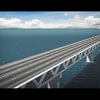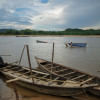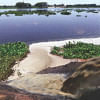Sewage taints rivers, canals
In the absence of modern treatment facilities, a cringe-worthy 80 percent of the capital's sewage goes directly into rivers and water bodies.
The mindless dumping through the city's storm drainage system is wreaking havoc on the water sources and eventually affecting public health.
At its plant in Narayanganj's Pagla, Dhaka Water and Sewerage Authority (Wasa) is able to treat sewage from only 20 percent of the city area, according to official documents.
“It is really deplorable that 80 percent of the waste produced by 1.75crore people in the capital has increased many times the pollution of rivers around the city turning it very difficult to treat the water,” a local government ministry letter reads.
The letter addressed to the housing and public works minister on June 7 says that rivers are being contaminated by septic tanks illegally connected to the storm drains.
The LGRD and Cooperatives Minister Khandker Mosharraf Hossain in his letter called upon the housing minister to make Rajdhani Unnyan Kartripakkha (Rajuk) ensure proper septic tanks at every house and prevent such connections while issuing building permits.
The 1984 building construction rules dictate that each owner should set up septic tanks or soak pits and manage the sewage on their own. But to avoid cleaning costs, most people connect the pits to the storm drains. Some do not even bother setting up tanks or pits and dump the faeces directly to the storm drains.
Rajuk can fine a minimum of Tk 50,000 or cancel the building's approval for violating the 1984 rules, Shah Alam Chowdhury, a Rajuk director, said, adding that they have not been able to do that as they are overwhelmed with other work.
Rajuk Chairman Md Abdur Rahman could not cite an example of a building owner being penalised for the offence.
“I don't know why it was not done in the past but now we along with Dhaka Wasa should go for legal action.”
Rajuk has started putting a seal on the construction permit stating that septic tank was mandatory, he added.
A number of city dwellers said they had no clue as to where the faecal waste went and what it meant to public health and environment.
“We have never thought of how it should have been managed,” said Shirin Sultana, a resident of Bailey Road.
Abdur Rashid, caretaker of a building in Gulshan, said that waste disposal pipes in his building first release the sewage into a pit which is connected to roadside surface drains of the neighbourhood.
The surface drains that are connected to the much larger storm drains, ultimately take the matter flushed down the toilet, to canals, wetlands and rivers.
A Wasa official, seeking anonymity, said in most cases they cannot detect the illegal connections to storm drains because the pipes are under the ground.
But Kazi Golam Nasir, chief architect of the Department of Architecture, said, the irregularities could have been easily detected if Rajuk strictly inspected and issued occupancy certificates before residents moved in the new buildings.
Hasin Jahan, country director of Practical Action, an international NGO that works on urban waste, water and sanitation, said the conventional methods of managing sewage at a far-away treatment plant would not work in Dhaka due to unplanned urbanisation.
Moreover, the faecal sludge would not automatically move in a certain direction on a plain surface, she said.
Septic tanks or soak pits at every house and localised treatment plants for cluster neighbourhoods might help, she said, adding that the Rajuk, Wasa and city corporations would have to coordinate work to make that possible.
According to experts, the Buriganga, Shitalakkhya, Balu and Turag rivers that are the sources of fresh water around the capital are becoming highly contaminated by human waste and industrial effluents causing public health hazards.
Prof Meerjady Sabrina Flora, director of Institute of Epidemiology, Disease Control and Research, said direct consumption and other uses of contaminated water can cause diarrhoea, deadly Hepatitis-A and E and typhoid through the feco-oral route (fecal contamination through mouth).
“We have found faecal contamination in water through tests. At times, sewage lines are found connected with even water supply lines. There are chances that polluted water would contaminate food and it is an enormous concern for public health.”
Prof Mohammad Ali, who conducted the first liver transplantation in the country, said deadly hepatitis-A and E and typhoid can eventually lead to liver failure, particularly in children and pregnant women.
Due to pollution in other rivers, Dhaka Wasa, that serves about 400 square kilometres, uses water of only the Shitalakkhya at its treatment plant at Sayedabad to meet only 22 percent of the daily demand for 230 crore litres of fresh water. The rest is groundwater.
The groundwater table, however, drops by around three metres a year with roughly 1.5 metre of annual recharge, according to a government estimate.
The government has undertaken expensive projects like Jasaldia (Mawa) and Gandhabpur (Narayanganj) water treatment plants to fetch water from the Padma and Meghna, from a distance of 33km and 23km to supply surface water to the city.

 For all latest news, follow The Daily Star's Google News channel.
For all latest news, follow The Daily Star's Google News channel. 








Comments